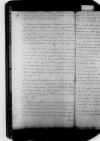List #5768
Alfonso de VALDÉS do Ioannes DANTISCUS[Regensburg], [ca. 1532-04-16?]
Regest polski: Valdes prosi Dantyszka, aby przysłał mu jego portret, jeśli jest już gotowy, ponieważ pan Granvelle chce go obejrzeć, by móc zdecydować, czy zlecić temu samemu malarzowi namalowane swojego. Valdes zwraca Dantyszkowi przeczytane dziełko historyczne (historicum tuum Sycophantam) i prosi o zwrot książeczki Juan’a Ginés de Sepúlveda, ponieważ chce ją dołączyć do listu do Erazma.
Rękopiśmienne podstawy źródłowe:
Pomocnicze podstawy źródłowe:
Publikacje:
| ||||||||||||||||||||
Tekst + aparat krytyczny + komentarzZwykły tekstTekst + komentarzTekst + aparat krytyczny
Salutem.
Dominus
ms 1 2 Gniesii⌈
ms 1 2 Gniesii⌉ libellum[1] ad me mittito, ut eum litteris[2] meis ad
Vale.
print 1 Tuus Valdesius,
ms 1 2 omitted⌈Tuus
ms 1 2 omitted⌉


 BK 222, No. 54, p. 198
BK 222, No. 54, p. 198